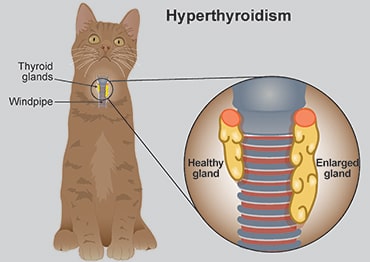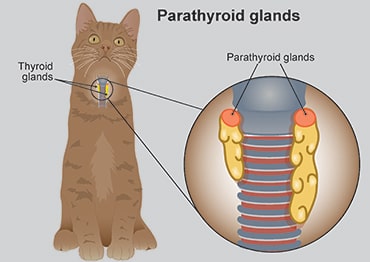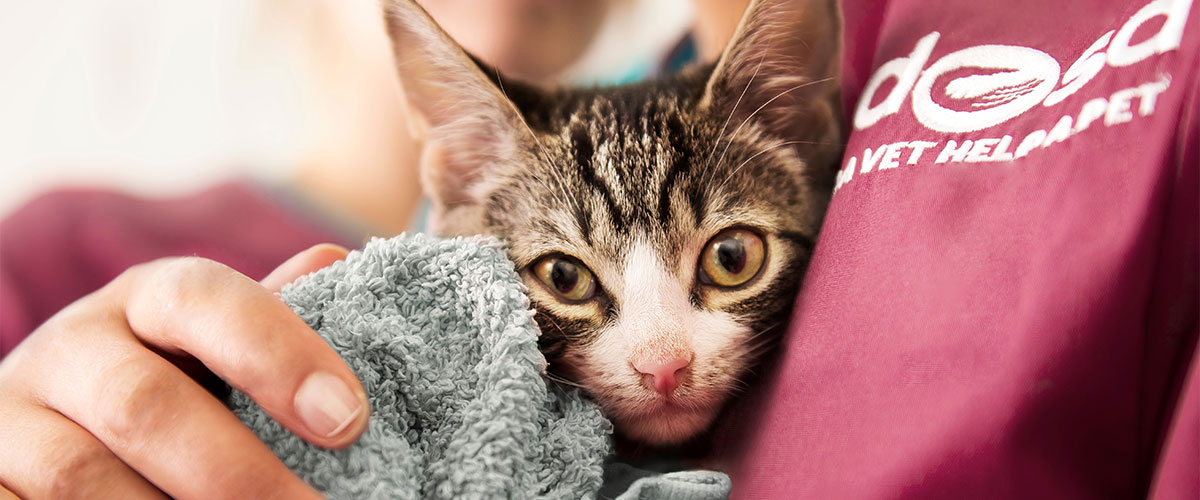Hyperthyroidism in cats
Overview
- Hyperthyroidism is a condition that causes one or both thyroid glands to become enlarged and overactive.
- 97-99% of cases are due to benign swellings in the thyroid; 1-3% are due to cancerous growths.
- Hyperthyroidism causes weight loss, increased appetite, restlessness and many other symptoms.
- Symptoms tend to develop slowly but hyperthyroidism is serious and can be fatal if left untreated.
- Many treatment options are available and well managed hyperthyroid cats can live for many years.
What is hyperthyroidism?
Your cat has two thyroid glands in their neck that control their metabolism.
Hyperthyroidism is over-activity in these thyroid glands. The vast majority of cases are caused by harmless swellings but some rare cases are caused by cancer (1-3% of cases).
Hyperthyroidism causes a high metabolism, which has many negative effects on the body. Weight loss, a high heart rate and high blood pressure are just a few of the common problems encountered by hyperthyroid cats.
Symptoms appear slowly, so you may not notice a problem at first but left untreated over a long period, hyperthyroidism can be fatal.
Hyperthyroidism is most common in middle aged to older cats.

Hyperthyroidism is over-activity in the thyroid glands.
Symptoms
An overactive thyroid can cause the following symptoms:
- An increased appetite
- Weight loss
- Hyperactivity, noisy and demanding behaviour
- Drinking and peeing more
- Sickness and diarrhoea
- A dry, untidy coat
- Low energy (lethargy).
You might also notice:
- One or two small lumps in the neck under the skin
- A very fast heartbeat (you may feel this when your cat is sat on you)
- Hair loss (alopecia).
Treatment
There are a few different treatment options for hyperthyroidism. Discuss the options with your vet to find out which is best for your cat.
The two most common ways to treat hyperthyroidism include:
- Medication to slow the overactive thyroid gland(s)
- Surgery to remove the gland(s)
Medication
- Tablets or liquid medication can be used to control hyperthyroidism. Treatment is for life, if you stop medication, symptoms will return.
- Your cat will need regular vet checks, blood tests and monitoring at home.
- Giving a cat a tablet can be tricky, some cats tolerate it well and others find it stressful.
Surgery
- Thyroid glands can be removed, which means your cat won’t need to be given medication anymore.
- If your cat is suitable for surgery, you will first need to settle their thyroid by giving them medication for 3-4 weeks.
- Any surgery has risk attached to it, removing thyroid glands is no exception. A tiny gland called the parathyroid sits right next to each thyroid gland. It controls your cat’s calcium levels. If these glands are damaged during surgery, your cat is likely to become poorly and need treatment for low calcium (hypocalcaemia). The risk is much higher if both thyroid glands are removed.
Less common treatments:
- A low iodine diet can be used to treat hyperthyroidism. Reducing iodine in your cat’s diet prevents the thyroid being able to over produce thyroid hormone. If you decide to use this as a treatment option your cat cannot be fed anything else.
- Radioactive iodine treatment – certain specialist veterinary hospitals offer radioactive iodine treatment to destroy thyroid glands without surgery. This is suitable if you don’t want to tablet your cat every day and are worried about surgery.

The parathyroid sits right next to each thyroid gland
 Video found at youtu.be/D-R383L64LI
Video found at youtu.be/D-R383L64LI
Ongoing care
If you decide to treat your cat with tablet medication, make sure that you follow instructions and visit your vet for check-ups and blood tests.
If your cat has had surgery, they should return to normal after a few weeks – gaining weight, eating less and generally looking a lot healthier. If the surgery is successful, you shouldn’t need to revisit your vet after your cat has fully recovered.
Outlook
The vast majority of hyperthyroid cats can be treated successfully. However, it’s important to remember:
- Hyperthyroidism is sometimes caused by thyroid cancer. It’s very rare (1-3% of cases) but if your cat is unlucky enough to have one of these rare thyroid cancers their condition may not improve.
- If your cat has one of their thyroid glands removed, the other gland may develop the same problem further down the line. If this happens, symptoms will return.
- Removing both thyroid glands puts your cat at risk of developing low calcium.
Cost
Treatment for a cat with hyperthyroidism can become expensive. Consider insuring your cat as soon as you get them, before any signs of illness start. Then you have all the support you need to care for them.
It’s very important to speak openly to your vet about your finances, the cost of treatment, and what you think is right for your cat. There are often several treatment options so if one doesn’t work for you and your pet, your vet may be able to offer you another.
Kidney disease and hyperthyroidism
Sometimes, treating hyperthyroidism uncovers hidden kidney disease. You may not see any signs of kidney disease in a cat with hyperthyroidism. This is because overactive thyroid glands cause increased blood flow to the kidneys, which supports them. If your cat has kidney disease, they are likely to start showing signs when their hyperthyroidism is treated and their blood pressure falls back to normal. If this happens, you will need to discuss treatment options with your vet.
Published: November 2018
Did you find this page useful?
Tell us more
Please note, our vets and nurses are unable to respond to questions via this form. If you are concerned about your pet’s health, please contact your vet directly.
Thank you for your feedback
Want to hear more about PDSA and get pet care tips from our vet experts?
Sign up to our e-newsletter
Written by vets and vet nurses. This advice is for UK pets only. Illustrations by Samantha Elmhurst.

